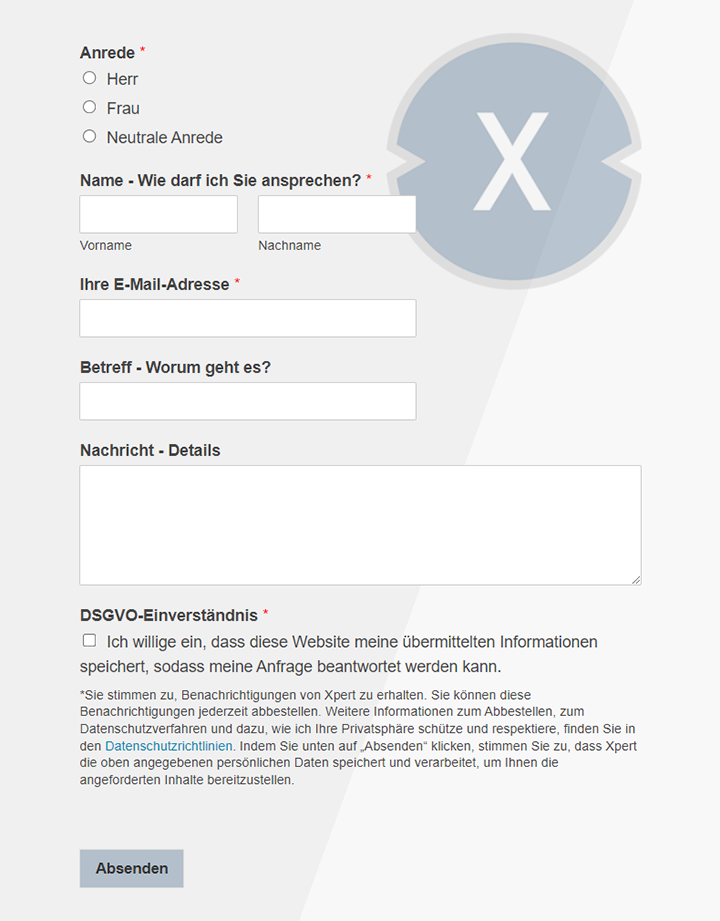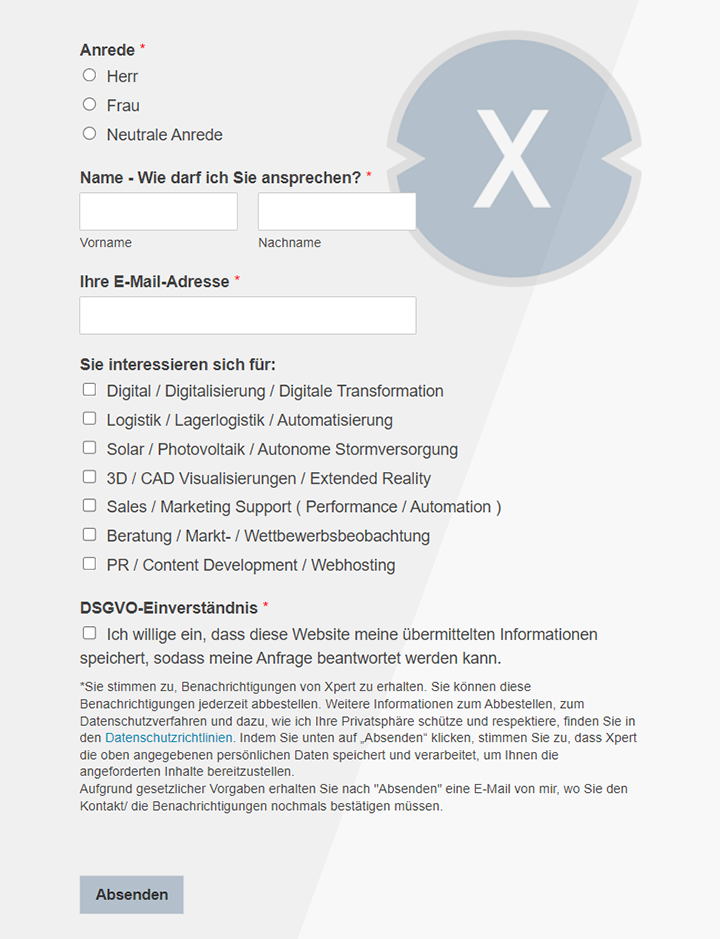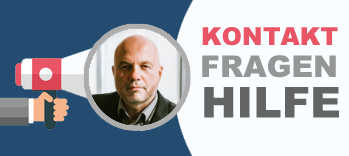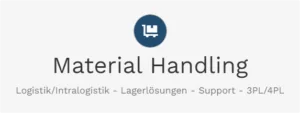Business development with Accio: Not only applicable as an AI-based B2B search engine and sourcing platform
Xpert pre-release
Language selection 📢
Published on: July 1, 2025 / update from: July 1, 2025 - Author: Konrad Wolfenstein

Business development with accio: not only applicable as an AI-based B2B search engine and sourcing platform-Image: Xpert.digital
AI-based business development: How Alibabas Accio makes companies into global players and transforms business ideas into market maturity products
The Accio Ecosystem: A paradigm shift from the search for strategic development-how artificial intelligence transforms passive search into active business strategy
The introduction of accio by Alibaba marks a decisive turning point in the landscape of global B2B trade. Accio is a comprehensive ecosystem for business development far more than an incremental improvement in existing procurement platforms. It was designed from the ground to orchestrate the process from the vague idea to the market -like product. This analysis will deconstruct the architectural basics and core functions of Accio to show how the platform enables fundamental change from passive, keyword-based search for active, AI-supported strategic formulation. For small and medium -sized companies (SMEs), this means democratization of tools that have so far only been available to large corporations, thus opening up new ways for global growth and innovation.
Suitable for:
- This AI platform combines 3 decisive business areas: procurement management, business development & intelligence
The architectural basis: "Ki-Native" by design
In its conception, accios performance is rooted as a "AI-Native" application. In contrast to platforms that add AI functions as a subsequent addition, ACCIO is the artificial intelligence and their skills of the core of the entire architecture.
Core technology stack
The platform is based on the fundamental AI technologies of Alibaba, especially the source-open large voice model (LLM). This basis is supplemented by the integration of further leading models such as Deepseek and GPT-4O, which indicates a best-in-class approach in the AI engine. This technological diversity enables accio to process complex inquiries with remarkable nuancing and accuracy.
Data -based logical closing
The decisive strategic advantage of accio lies in the symbiosis of its AI models with the proprietary database of Alibaba. The models are not only trained with general internet data, but specifically with the data from 25 years of global B2B trading. This data record comprises over 50 million companies, 1 billion product lists and transaction data from over 7,600 product categories. While a generic LLM can lead a general conversation, it is training with these specific, structured merchant data that accurately gives the ability to "think" like an experienced procurement expert. It can evaluate the reliability of suppliers, understand industry-specific terminology and provide commercially relevant insights-skills that go far beyond the possibilities of a standard AI model.
Conversational and multimodal interface
Accio breaks with the rigid logic of the keyword -based search. The platform supports conversational inquiries formulated in natural language. A user can enter a vague idea such as "I want to build a ski area in the desert" or upload complex requirement documents. The interface is multimodal and can process texts, images, videos and even 3D models as input, which makes the search and development process considerably more intuitive and accessible.
The intelligence suite: deconstruction of the core functions of accio
The strategic power of Accio manifests itself in a suite of closely integrated tools, each addressing a specific phase of business development.
AI-based B2B-Wikipedia
This function acts as a business intelligence hub. It provides curated industry insights, detailed company profiles and comprehensive product specifications. For companies, it acts as a kind of encyclopedia for B2B trading, which makes it possible to make sound decisions based on market trends and competitive data.
Deep search
Far more than a search algorithm, acts as a virtual procurement expert. The system understands complex requirements such as technical specifications, required certifications (e.g. CE, FCC) or budget restrictions. If a first request finds only a few results, the AI refines the search intelligently by using synonyms or industry -specific terms. It is crucial that deep search suppliers checks for conformity and reliability and, based on Alibabas, delivers extensive merchant data AI-curated selection lists.
Super comparison
This engine enables a direct comparison and analysis of several products, suppliers and price models. It provides data -based comparisons that enable companies to select the most cost -effective and reliable options for their procurement requirements and thus optimize their purchasing strategies.
Accio-agent
This feature is a AI-based trading assistant that automates routine tasks such as lead generation, supplier negotiations and even the design of orders. The agent works around the clock and thus overcomes time zone barriers, which enables an "unmanned operation". This automation goes beyond pure increase in efficiency; It represents a functional relief for administrative and operational roles. For SME, this means the ability to operate a global sales and procurement desk 24/7 without having to hire additional staff. The case of a manager from YIWU, who concluded a $ 20 million contract with an Arab customer through the agent, underlines the potential to deal with high-quality and complex interactions.
Product encyclopedia & Accio Page
Prody encyclopedia dynamically shows multi-dimensional data on products, including specifications, price ranges and end customer sales data. At the same time, companies can create AI-based digital shop windows with the Accio Page Page to increase their visibility on the global B2B marketplace and attract international buyers.
The strategic change: from finding products to discover opportunities
The true innovation of accio is not in the individual functions, but in its synergetic effect. The platform changes the role of the user from a pure “searcher” to a “strategist”. It aims to shift the decision -making process of intuitive gut decisions to data -based, logical conclusions. The Mission of Accio to redefine “Your Procurement Experience” aims to transform every entrepreneurial idea into a tangible global product and thus democratize AI technology for SMEs in order to give them the same resources and skills as large companies.
The following table summarizes the core functions of Accio and their direct applications in business development and serves as a reference for deeper analysis in the following sections.
The strategic change leads from easy finding products to systematic discovering new business opportunities. Business Research automates the collection and analysis of market data and generates structured reports and business plans, which enables fast market entry analyzes, the validation of business ideas and the creation of implementable business plans. Deep Search carries out complex, nuanced searches and checks suppliers for reliability and conformity, which contributes to the identification and review of strategic partners, to risk reducing in the supply chain and to ensure product quality. Product Inspiration analyzes real-time web and social media trends to generate profitable product ideas and thus enables data-based identification of market niches and trend products as well as the reduction of risk in product launch. Super Comparison enables the direct comparison of products, suppliers and price models side by side and contributes to the cost optimization, strategic supplier selection and improvement of the negotiation position. ACCIO Agent finally automates communication and transaction processes such as inquiries, negotiations and orders and thus enables the scaling of the global operation without additional personnel, increase in efficiency and overcoming time zone barriers.
From the concept to the market: implementation of a data -controlled business development strategy with Accio
Accio is more than just a collection of tools; It represents a structured, sequential workflow for business development. The functions are designed in such a way that they logically guide a user from the first idea to the final implementation. This approach significantly reduces the cognitive burden and the required expertise and makes strategic business development accessible to non-specialists. This section outlines this process chronologically and shows how an entrepreneur can use accio to transform a business idea into a market -strip plan.
Suitable for:
Phase 1: Opportunity recognition and finding of ideas (product inspiration)
The business development process with Accio does not begin with a specific product, but with an idea, a market or a problem.
The impetus
The user initiates the process by setting the search mode for "opportunities". Instead of a precise key word, a broad request such as "winter products" or an abstract goal, such as the already mentioned, "ski area in the desert" can be entered. This flexibility makes it possible to explore immature ideas.
The data synthesis
Accio now begins with the synthesis of real -time data from a variety of sources. This includes social media trends, general web insights and the specific B2B e-commerce knowledge from the alibaba ecosystem. The AI analyzes a number of key factors, including estimated winning margins, search volumes on various platforms, retail sales data and a proprietary "niche score" that evaluates the potential of a gap in the market.
The result: data -based ideas of ideas
Based on this comprehensive analysis, Accio generates hundreds of creative and tailored product ideas. This process transforms the product selection from a purely intuitive, often risky decision into a data -based strategic choice. User reports confirm the efficiency of this approach: Products whose identification traditionally months of research and countless offer inquiries (RFQS) would have been required can now be found within minutes. The functionality is compared with specialized e-commerce research tools such as Jungle Scout, which underlines its performance in the identification of profitable products.
Phase 2: Market validation and strategic planning (business research)
As soon as a promising product idea has been identified, the process enters the validation and planning phase, which is supported by the business research function.
From the idea of the plan
The user can now formulate a specific goal, for example "I want to introduce this environmentally friendly pet toy on the German market".
Automated market analysis
The function automates the otherwise extremely labor -intensive task of market analysis. Instead of collecting reports and consolidating data, the tool generates structured real-time reports on consumer demand, price trends and the competitive landscape for the specific product in the target region.
The result: a implementable business plan
The decisive added value of this function is that Accio not only provides data, but a feasible strategy. The result is a finished business plan that already contains cost estimates and initial supplier recommendations. This compresses months of strategic preparatory work in a few minutes and enables SME to react to market opportunities at unprecedented speed. This step creates a crucial feedback mechanism that allows entrepreneurs to evaluate the financial load capacity of an idea almost immediately. If the AI-generated cost estimates are too high or the recommended suppliers are too rare, the entrepreneur can switch to a new idea generated by product inspiration with minimal sunken costs. This enables a quick, iterative cycle of "Idea finding -> Validation -> Course correction/continuing" and de -specific before investing significant capital is invested.
Phase 3: Procurement and supplier examination (depth search & super comparison)
With a validated business plan in hand, the user passes into the implementation phase.
Precision procurement
Low search is now used to find suppliers who meet the specific requirements defined in the business plan. These can be technical specifications, materials, certifications or budget requirements. The system uses Alibaba's 25-year trading experience to check the suppliers for conformity and reliability and create a AI curated selection list.
Comparative analysis
The Super comparison tool is then used to compare the suppliers drawn in closer choice directly. Prices, minimum order quantities (MOQS) and other conditions can be rated side by side in order to select the most cost -effective and reliable partner.
Phase 4: Execution and automation (Accio-agent)
After selecting a supplier, the last steps of the process can be automated.
Automated processing
The Accio agent can take over the lead generation, initial negotiations and even the design of orders. This rationalizes the final phase of the procurement process and reduces manual effort so that the entrepreneur can concentrate on overarching strategic tasks.
🎯🎯🎯 Benefit from Xpert.Digital's extensive, fivefold expertise in a comprehensive service package | R&D, XR, PR & SEM

AI & XR 3D Rendering Machine: Fivefold expertise from Xpert.Digital in a comprehensive service package, R&D XR, PR & SEM - Image: Xpert.Digital
Xpert.Digital has in-depth knowledge of various industries. This allows us to develop tailor-made strategies that are tailored precisely to the requirements and challenges of your specific market segment. By continually analyzing market trends and following industry developments, we can act with foresight and offer innovative solutions. Through the combination of experience and knowledge, we generate added value and give our customers a decisive competitive advantage.
More about it here:
RETALOS GmbH as a pioneer: Berlin Retail-Tech company shows successful use of Alibabas Accio for innovative product development
Regional focus: Use of Accio in the German B2B market
While the global abilities of Accio are impressive, the true test of its usefulness is in use on specific, highly developed regional markets. This section analyzes the suitability of Accio for the German and the Dach market (Germany, Austria, Switzerland) by examining the special market conditions and showing how the functions of the platform are tailored to the needs of German SMEs.
Suitable for:
- AI-supported procurement management, purchasing and controlling: an analysis of accio.com and market alternatives
The German B2B e-commerce landscape: a market full of opportunities and special features
The German market represents a unique mix of enormous potential and specific business cultural requirements.
Market size and growth
The German B2B e-commerce market is the largest in Europe and is on a steep growth course. Forecasts assume that he will reach a volume of over $ 1 trillion by 2030, with an average annual growth rate (CAGR) of 19.4 %. This dynamic creates an immense opportunity for digital platforms that make trade easier.
Cultural and business dynamics
German business culture, especially in the middle class, traditionally attaches more importance to quality, reliability and long -term partnerships than at the lowest price. Trust is the currency of the business. In addition, compliance with strict data protection regulations such as the GDPR (GDPR) is not just a legal requirement, but a sign of professionalism. The localization of offers and communication in German are often crucial for success.
Digital adaptation
German companies are increasingly investing in the digitization of their supply chains and B2B e-commerce platforms, driven by state initiatives such as "Industry 4.0". The high internet penetration and the growing trend for integrating AI and data analysis in business processes also promote this digital adaptation.
The market recorded a size of $ 301.5 billion in 2023 and is expected to grow to USD 1,045.4 billion by 2030, which corresponds to an average annual growth rate of 19.4 percent in the period from 2024 to 2030. The “Industry 4.0 ″ initiative, the digitization of the supply chains and the high internet penetration are considered important growth drivers.
The cultural business standards in Germany are characterized by a high value for quality, reliability and trust. Companies must ensure strict compliance with the GDPR and show a significant preference for long -term partnerships.
Accios strategic focus on the German market
Accio's functions not only seem to be useful for the German market, but strategically designed to overcome the specific cultural and operational hurdles with which German SMEs are confronted with global procurement.
Targeted strategy
Alibaba has explicitly identified Europe and North America as key markets for Accio and implemented support for languages such as German, French and Spanish from the start. Over 1,700 German brands are already using the Alibaba ecosystem, and leading German companies such as Bosch, Siemens and SAP work with Alibaba Cloud, which underlines the deep anchoring in the market.
Addressing German economics
The German business culture is analytical and fact -based. The functions of business research and product inspiration provide the hard data on market trends, competition and profitability that are necessary to justify and defend a strategic decision internally.
Quality & reliability: One of the greatest hurdles for German companies when using global platforms is the uncertainty regarding the quality of supplier. Accios deep search function that checks suppliers for conformity and reliability addresses this concern directly. It offers a verification mechanism that goes beyond simple filters and creates trust in digital, distant business relationships, which meets the German need for security and quality.
Data -based decision -making: German business culture is analytical and fact -based. The functions Business Research and Product Inspiration provide the hard data on market trends, competition and profitability that are necessary to justify and defend a strategic decision internally.
Efficiency and automation: The AcciO agent and the optimized workflows of the platform directly address the German focus on process efficiency, a core principle of Industry 4.0.
Global range for medium -sized companies: Accio equips the powerful German middle class with tools in order to be globally competitive. It democratizes access to market analyzes and a global supplier network, resources that were previously reserved for large corporations.
Reversed business development: recognize export opportunities
While the focus is often on procurement, Accio offers an equally powerful opportunity for the reverse direction. The high demand for German products such as Energy Drinks, Whiskey and Beer on Alibaba in markets such as Vietnam and India shows considerable export potential. A German SME can use ACCIO's business research function to specifically analyze the demand for "Made in Germany" products in foreign markets. The platform can be used to validate international markets before investing in expensive export logistics and marketing, which makes Accio a potent tool for the export strategy.
Case study: Retaylos GmbH - an archetype for innovative procurement
The practical application of accio by a German SME can be illustrated using the example of retayless GmbH.
Company profile
RetAlos GmbH is a retail tech company based in Berlin, founded by Fynn Huch. The business model includes the operation of intelligent, data-controlled sales machines that serve as interactive advertising and sales platforms- a B2B2C model.
Use of Alibaba/Accio
The participation of Fynn Huch in a webinar about purchasing on Alibaba.com strongly indicates that the platform is used for strategic procurement. For a technologically demanding product such as an intelligent automatic sales machine, this probably means the procurement of special components. Touch screens, cashless payment systems, IoT hardware for data transmission and possibly even the housings of the machines could belong to this.
Strategic implications
The retail case shows an example of how a German SME can use a platform like Accio not only for the purchase of ready -made goods, but also for building a complex, innovative product. It enables access to the global supply chain for high-tech components and thus supports a business model that combines physical hardware with a SaaS-like data service. This is a prime example of the use of global procurement to promote local innovation and to create a competitive advantage on the domestic market.
A comparative framework: the ROI digital ecosystems compared to traditional channels
For a sound strategic decision, the advantages and costs of new digital tools must be weighed against established methods. This section offers a quantitative and qualitative comparison between the use of a digital platform such as Accio for business development and participation in a traditional German leading fair such as the Hannover Messe. The aim is to create a clear framework for the evaluation of the Return on Investment (ROI).
The traditional approach: the German trade fair
Masses have long been a cornerstone of B2B business development in Germany and offer undeniable advantages, but are also associated with considerable costs and challenges.
Advantages
The invaluable value of trade fairs lies in personal contact. They enable direct face-to-face interactions, the establishment of trust and long-term relationships, the interactive presentation of products and the analysis of the competition on site. Participation also signals industry competence and thought leadership.
The cost structure
A trade fair division is a significant investment. The total costs are made up of several components:
Standing area: The rental prices in Germany are an average of € 180 and € 300 per square meter, at leading fairs such as EMO Hannover it can be up to € 396/m². A small stand with 16 m² can cost over € 3,200 at area rent alone.
Stand construction and design: The costs for this vary greatly, from simple system stalls for approx. 120 €/m² to elaborate, individual constructions that can cost 450 €/m² and more.
Additional costs: Personnel costs, travel and overnight stays, marketing materials, hospitality and various service fees (e.g. media flat rate, Auma contribution, waste disposal) can easily double or triple the basic costs. Realistic total costs for a SME at a large European trade fair can quickly be between € 15,000 and € 50,000.
The challenges
Despite the advantages, trade fairs fight with falling visitor numbers and increasing costs. However, the biggest challenge is the measurability of success. According to a survey, 54 % of the exhibitors indicate that the inability to pursue results and the ROI are their biggest problem. The often long sales cycle in the B2B area makes it difficult to assign sales to a trade fair contact.
The digital approach: the Accio ecosystem
Accio offers a fundamental other approach to business development, which is designed for scalability, efficiency and measurability.
Advantages
The platform offers a global range that is accessible 24/7 and overcomes geographical borders. It is extremely cost -effective at low fixed costs and enables enormous increase in efficiency through automation and data -based decisions. Direct access to a huge, verified supplier network is another core advantage.
The cost structure
The model is usually subscription -based or transactionally. While there are no specific prices for accio, seller plans on Alibaba.com start at around $ 166 a month. This represents a fraction of the costs of a single trade fair division. The main investment is time and strategic commitment, not massive capital.
The strengths: measurable ROI
In contrast to uncertainty at trade fairs, almost every interaction can be measured in digital space. Any request, every click and any generated lead can be followed digitally. The platform itself provides data on conversion rates, such as the 30%increase in the supplier conversion by the Accio Inspiration function. This enables precise calculation of customer acquisition costs and ROI.
A comparative ROI analysis
The comparison of the two approaches reveals a fundamental difference in the risk profile. A trade fair division is a speculative investment: a company makes a high prepayment in the hope of making valuable contacts at the event. The success is uncertain. Accio reverses this model. It enables data -based validation at low costs before a significant investment is made. With Accio, an entrepreneur can validate a market chance that estimates profitability and find reliable partners before he commits a large order or a market entry. The great financial obligation only takes place after the risk has been minimized by data.
This leads to an even more powerful hybrid model: A company can use Accio to carry out a targeted market analysis beforehand and create a highly qualified selection list of potential partners. The expensive, personal time at the fair is then not used for speculative cold acquisition, but for the deepening of relationships and the conclusion of already initiated shops. This maximizes the ROI of the physical event by using the inexpensive efficiency of the digital platform for the preparation.
The comparative ROI analysis between acci-based business development and traditional trade fairs such as the Hannover Messe shows significant differences. While the initial investment in acci-based solutions only requires a low monthly subscription fee of around $ 166 per month on platforms such as Alibaba.com, companies for traditional trade fairs have to calculate between 15,000 and 50,000 euros or more.
The global range also differs significantly: Accio-based business development offers global access to millions of partners in over 100 markets around the clock, while traditional trade fairs are limited in the long run and the location of the event and are primarily regional or industry-specific reach.
In the quality and testing of the leads, the digital variant with AI-based testing of suppliers scores on reliability and conformity as well as data-based partner selection. Traditional measurements, on the other hand, often generate unqualified leads, the examination of which must be manually and time -consuming on site.
The speed from the concept to the plan is impressive for acci-based solutions: within minutes to hours a validated business plan can be created with supplier recommendations, while traditional trade fairs require months of preparation, implementation and follow-up.
The ROI measurement and tracking is digitally more precise by persecution of conversions, costs per lead and ROI using digital analysis. At traditional trade fairs, this is very difficult to measure, which is why 54 percent of the exhibitors call this as their main problem.
Finally, the risk profile also differs significantly: Accio-based business development offers a low initial risk with data-based validation before the main investment, while traditional trade fairs represent a high initial risk and mean a speculative investment with an uncertain outcome.
Safe through digital world trade: the ultimate risk management guidelines for B2B platforms
Navigation on the global marketplace: a frame for risk reduction on accio
A balanced expert report must examine both the opportunities and the risks. The use of global B2B platforms is inseparable with challenges that range from fraud to quality problems. This section offers a sober evaluation of these risks and provides a structured, implementable framework to systematically reduce it when using accio.
The inherent risks of global B2B platforms
Despite the advanced tools from Accio, the basic risks of international online trade remain because many problems arise from the individual suppliers.
Supplier and payment fraud
Dealing with non-verified suppliers, "Bait-and-Switch" tactics (in which an attractive product is advertised, but an inferior product is delivered) and sophisticated payment fraud (e.g. by chopped email accounts and fake invoices) are considerable financial risks.
Quality control problems
Product photos and descriptions can be misleading, which leads to the preservation of inferior or false goods. A lack of or inconsistent quality control in the production facility is a frequent cause of customer -free satisfaction and financial losses.
Violation of intellectual property (IP)
There is a risk of purchasing fake products or that your own designs and brands are copied by unscrupulous providers. This can lead to legal consequences and reputation damage.
Operative and logistical challenges
Misunderstandings due to language and cultural barriers, high minimum order quantities (MOQS), which are impractical for SMEs, as well as unexpected delays and costs when shipping can significantly disrupt business operations.
A gradual strategy for supplier risk management
The most effective strategy for risk reduction is a mix of the use of the tools provided by the platform and the implementation of independent, external verification processes. It is inadequate to rely exclusively on the protective mechanisms of the platform, while their ignoring would be inefficient.
Step 1: Early evaluation and risk profile
A risk assessment should take place before the first contact. Categorize potential suppliers according to your risk level (e.g. strategically critical vs. uncritical) and evaluate the importance of the category to be procured for your own business. Use ACCIOS FLEET FOLD function and the supplier verification data as the first filter to make a pre-selection.
Step 2: Strict Due Diligence (the Kyss process)
Implement a rigorous "Know Your Supplier" (Kys) process. Search for "Verified Suppliers" on the platform. Request business licenses, quality certificates and references and check them. The most important step is to always request product patterns before a large order is given up to assess the quality itself.
Step 3: Diversification and emergency planning
Avoid the dependency on a single supplier, especially with critical components. Diversify your supplier base, ideally across various geographical regions, to reduce geopolitical or logistical risks. Develop emergency plans with already tested replacement suppliers.
Step 4: Safe transactions and contracts
Never do a 100%advance payment. A common and recommended payment structure is a deposit of 30 % and the remaining 70 % after completing production and a successful quality inspection by third parties. Use the Alibaba Trade Assurance Service without exception. This acts as a trust service, which holds the payment back until the buyer is confirmed and offers a dispute settlement mechanism. Complete clear, detailed contracts that hold all conditions, quality requirements and delivery times.
Step 5: Continuous monitoring and performance tracking
Risk management is an ongoing process. Continuously monitor the performance of your suppliers, their compliance status and the general market conditions. The data available in ACCIO can be used for predictive risk management. By analyzing trends at the response times of suppliers, price fluctuations in a certain category or regional logistics data can anticipate potential disorders before occurring. This makes it possible to re -switch to a replacement supplier or adapt it to a replacement supplier and thus to be transferred from a reactive to a forward -looking supply chain resilience.
The following checklist summarizes these strategic advice in a practical tool that the company can immediately use to improve their procurement practices.
Continuous monitoring and performance tracking requires different reduction measures for different risk categories. With supplier legitimacy, it is important to check the identity and reputation of the supplier by using the depth search, filtering according to the "Verified Supplier" status and checking the communication history. As an independent verification step, business licenses and certificates should be requested and a video call to visit the production facility should be carried out.
For the product quality, it must be ensured that the products meet the specifications. For this purpose, detailed product specifications are transmitted in the request and the super comparison is used for evaluation. The independent verification takes place through the request and examination of physical product patterns and the commissioning of an independent quality inspection before shipping.
Payment security protects against fraud and ensures the provision of services. Payments should only be made via Alibaba Trade Assurance and the Accio agent for documented negotiations. A payment structure of 30/70 is agreed as verification measures, never paid outside the platform and bank data is carefully checked.
When protecting intellectual property, it is about avoiding counterfeiting and protecting your own design. Suppliers with suspicious low prices for branded products should be avoided and the business research is used for competitive analysis. Independent verification includes sponsored research on Google Patent and the use of legal advice on your own designs.
Logistical disorders are tackled by reducing delays and unexpected costs. Delivery times and conditions are clearly negotiated via the Accio agent and the supplier location is checked. As a verification steps, a freight forwarder for logistics should be considered and emergency plans with alternative suppliers should be developed.
Strategic recommendations for implementation
Alibabas Accio is more than just a further development of B2B procurement platforms; It is a strategic instrument that has the potential to fundamentally change the way SMEs act globally. It relocates the focus from reactive procurement towards proactive, data -controlled business development. In order to fully exploit this potential, companies have to pursue a conscious and strategic approach. The following synthesis of the analysis leads to the business processes of SMEs in five central recommendations for the successful implementation of Accio.
1. Accept the paradigm shift
Companies should not consider accio as a pure procurement tool or search engine, but as a central hub for strategic business development. Teams should be trained to use the integrated workflow of the platform: from finding ideas (product inspiration) to market validation (business research) to precise implementation (depth search and accio-agent). This requires a rethink from traditional, isolated processes towards a holistic, AI-based approach.
2. Insert a hybrid business development model
Traditional channels such as trade fairs should not be fully abandoned, but should be added intelligently. Accio should be used to carry out a comprehensive market analysis and the examination of potential partners beforehand. This transforms expensive physical events of speculative lead generation events into targeted, highly efficient occasions at the end of shops and to deepen relationships, which significantly increases the ROI of these investments.
3. Prioritize regional nuances
When developing markets such as Germany, the data -controlled functions of ACCIO must be used to adapt products and business approaches to local values such as quality, reliability and data security. The platform provides the necessary information to develop a localized strategy instead of a global "one-size fits-all" approach, which often fails in sophisticated markets.
4. Implement a rigorous, mixed risk frame
The security in global trade is not negotiable. Companies should institutionalize the risk reduction checklist (Table 4) and make the standard procedure. The combined use of platform -owned protective mechanisms such as Trade Assurance and independent verification steps such as inspections by third parties must be binding. A compromise on this hybrid security approach can lead to considerable financial losses and reputation damage.
5. Explore the reverse business development
The greatest unused potential of accio for many western SMEs is in export promotion. Instead of only seeing the platform as a procurement channel, your market intelligence tools should be actively used to identify and validate export opportunities for your own products in new global markets. Accio can thus become a powerful engine for international sales and the global expansion of your own company.
In summary, it can be said that accio drastically reduces the entry barriers for global trade. It democratizes access to data and strategic tools and enables SME to act with agility and intelligence that was previously only reserved for large companies. However, success does not depend on the technology, but on the strategic foresight and disciplined implementation by the users.
We are there for you - advice - planning - implementation - project management
☑️ SME support in strategy, consulting, planning and implementation
☑️ Creation or realignment of the AI strategy
☑️ Pioneer Business Development
I would be happy to serve as your personal advisor.
You can contact me by filling out the contact form below or simply call me on +49 89 89 674 804 (Munich) .
I'm looking forward to our joint project.
Xpert.Digital - Konrad Wolfenstein
Xpert.Digital is a hub for industry with a focus on digitalization, mechanical engineering, logistics/intralogistics and photovoltaics.
With our 360° business development solution, we support well-known companies from new business to after sales.
Market intelligence, smarketing, marketing automation, content development, PR, mail campaigns, personalized social media and lead nurturing are part of our digital tools.
You can find out more at: www.xpert.digital - www.xpert.solar - www.xpert.plus






























